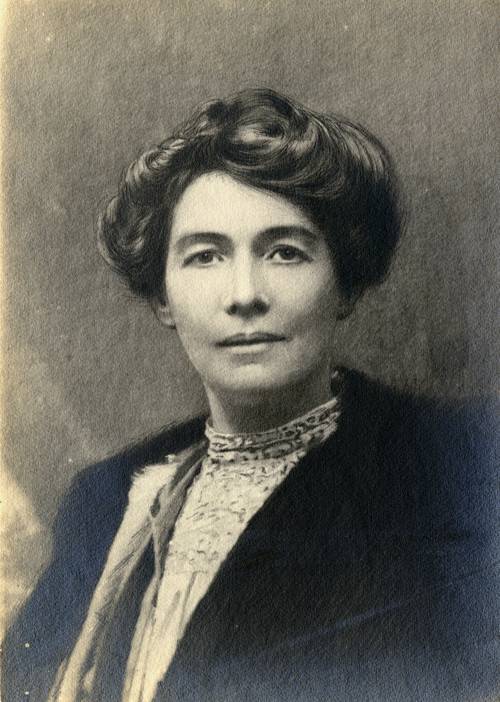
FAQ About Emmeline Pethick-Lawrence

Who was Emmeline Pethick-Lawrence?
Emmeline Pethick-Lawrence was a prominent British suffragette and social reformer, best known for her role in the women's suffrage movement and for co-founding the Women's Social and Political Union (WSPU) alongside Emmeline and Christabel Pankhurst. She played a significant part in advancing women's rights during the early 20th century.

What contributions did Emmeline Pethick-Lawrence make to the Women's Social and Political Union?
Emmeline Pethick-Lawrence co-founded the Women's Social and Political Union (WSPU) in 1903 with the Pankhursts. She served as treasurer and was responsible for the financial management and resource acquisition efforts, which were pivotal for organizing campaigns and protests. She also contributed to the WSPU's publication, Votes for Women, helping to amplify their message and coordinate their activities.

What were some key achievements of Emmeline Pethick-Lawrence in the suffrage movement?
Some of Emmeline Pethick-Lawrence's key achievements include co-founding the Women's Social and Political Union, effectively managing its financial resources, and contributing to the popularization of the suffrage movement through innovative campaigns and editorials in the publication Votes for Women. Her efforts significantly boosted the visibility and effectiveness of the campaign for women's voting rights.

How did Emmeline Pethick-Lawrence advocate for women's rights beyond the suffrage movement?
Beyond her suffrage work, Emmeline Pethick-Lawrence was involved in various social reform initiatives. She championed causes such as the abolition of poverty and supported workers' rights. Her activism extended to advocating for better working conditions and wages, especially for women laborers, through her involvement with organizations like the Women's Freedom League.

When and where was Emmeline Pethick-Lawrence born?
Emmeline Pethick-Lawrence was born on October 21, 1867, in Bristol, England. Her upbringing and early influences played a central role in shaping her commitment to social reform and women's rights.

How did Emmeline Pethick-Lawrence impact the publication 'Votes for Women'?
As co-editor of Votes for Women, Emmeline Pethick-Lawrence significantly shaped the publication's content and outreach strategy. She used this platform to disseminate information about the suffrage movement, mobilize support, and report on the activities of the WSPU, thereby educating and engaging both the public and potential supporters.

Did Emmeline Pethick-Lawrence face any legal challenges during her activism?
Yes, Emmeline Pethick-Lawrence faced legal challenges due to her activism. In 1912, she was arrested and imprisoned for her involvement in the suffrage movement’s window-smashing campaign, a form of protest against governmental inaction on women's suffrage. These arrests were part of a series of clashes with the authorities as suffragettes sought to draw attention to their cause.

What was Emmeline Pethick-Lawrence's approach to fundraising for the suffrage movement?
Emmeline Pethick-Lawrence was highly effective in fundraising for the suffrage movement. She used innovative methods, including organizing social events, such as concerts and exhibitions, to raise both awareness and financial support. Her strategic oversight ensured the WSPU had the necessary resources to sustain its campaign efforts.

What role did Emmeline Pethick-Lawrence play in the Women's Freedom League?
Emmeline Pethick-Lawrence supported the Women's Freedom League, an organization that worked for women's vote rights through non-violent means. While her primary focus remained with the WSPU, she aligned with the League’s broader feminist goals and occasionally participated in its advocacy for women's legal and social rights.

How is Emmeline Pethick-Lawrence remembered today?
Today, Emmeline Pethick-Lawrence is remembered as a key figure in the British women's suffrage movement. Her dedication to social justice and her creative approach to activism have left a lasting impact. She is celebrated for her leadership, strategic mind, and her commitment to achieving political change for women.

What was Emmeline Pethick-Lawrence's contribution to women's working conditions?
Emmeline Pethick-Lawrence worked to improve women's working conditions by advocating for fair wages and better labor terms. She championed rights for female factory and industrial workers, pushing for reforms that would support economic independence and equality for women in the workforce.

Who did Emmeline Pethick-Lawrence marry and what was her husband's role in her activism?
Emmeline Pethick-Lawrence married Frederick Pethick-Lawrence, a lawyer and fellow activist. Frederick supported Emmeline's suffrage activities and was also deeply involved in the movement. Together, they were known for their progressive beliefs and joint activism, working as a partnership in advancing social and political reform.

What were the principles of Emmeline Pethick-Lawrence's suffragette activism?
Emmeline Pethick-Lawrence's activism was guided by principles of equality, justice, and non-violence. Although the WSPU utilized militant tactics, she believed in the ethical foundation of the cause, seeking justice through organized, strategic efforts. Her emphasis on fundraising and communications also reflected her strategic acumen in promoting these principles.

Did Emmeline Pethick-Lawrence hold any political office?
Emmeline Pethick-Lawrence did not hold a formal political office, but she exerted significant influence through her activism and organizational roles within the suffrage movement. Her work helped to lay the foundation for future women's political involvement and representation in government.

What was Emmeline Pethick-Lawrence's educational background?
Emmeline Pethick-Lawrence received her education at a progressive school in Bristol, which emphasized independent thinking and social responsibility. This formative education provided a basis for her later engagements in social reform and advocacy for women's rights.

How did World War I affect Emmeline Pethick-Lawrence's activism?
During World War I, Emmeline Pethick-Lawrence shifted some of her focus towards supporting the war effort, while still maintaining her commitment to women's rights. Like many suffragettes, she saw the war as a pivotal moment that could also serve as an opportunity for women to demonstrate their capabilities in society, thereby reinforcing their claims for equal rights.

What is a notable publication by Emmeline Pethick-Lawrence?
Emmeline Pethick-Lawrence co-edited Votes for Women, a prominent publication advocating for the suffrage movement. This magazine was instrumental in spreading the message of the movement, reporting on events, and galvanizing support among readers, reflecting her impactful contribution to media and activism.

Did Emmeline Pethick-Lawrence write any books or memoirs?
Yes, Emmeline Pethick-Lawrence wrote her memoir, My Part in a Changing World, which details her experiences and reflections on her life as an activist and reformer. This work provides personal insights into the suffrage movement and her contributions to social change.

How was Emmeline Pethick-Lawrence's relationship with other suffragette leaders?
Emmeline Pethick-Lawrence had a complex relationship with other suffragette leaders. While she co-founded and collaborated closely with Emmeline and Christabel Pankhurst, ideological and strategic differences eventually led to her expulsion from the WSPU in 1912. Despite this, she remained a respected and influential figure within the broader suffrage movement.

What legacy did Emmeline Pethick-Lawrence leave behind?
Emmeline Pethick-Lawrence left a powerful legacy as a leader who played a pivotal role in advancing women's rights. Her work with the WSPU and contributions to social reform movements left an indelible mark on the fight for gender equality. Her legacy is celebrated in historical accounts of the suffrage movement and in the ongoing struggle for women's rights.
